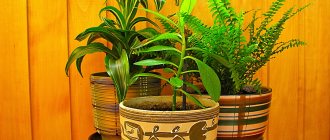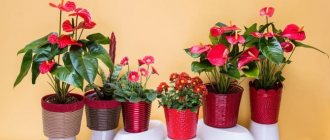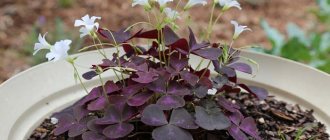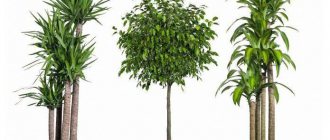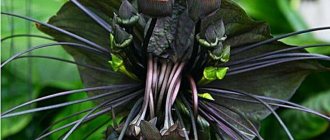Indoor plants are a seemingly completely ordinary and understandable thing. However, when it comes to buying them, it turns out that very few people really understand them: such a huge selection, so many different nuances - your head is spinning. We will tell you in this article which indoor plants are useful to keep at home and which are not.
Useful properties of indoor plants
Proper selection of indoor plants improves the microclimate in the house and the well-being of all its inhabitants. If you're still wondering whether to buy your first flower pot, here are some reasons for you.
Humidifier . During the heating season, the moisture level in the house drops to 20-30 percent, although 60 percent is considered the norm. Among the consequences of low humidity are dry mucous membranes of the nose and throat, flaking of the skin, the development of allergies, and respiratory diseases. Dry air is bad for wooden furniture and parquet floors. Growing indoor plants is one way to increase indoor humidity.
Plants that actively release moisture:
- Anthurium;
- Aglaonema (Aglaonema);
- Dieffenbachia;
- Maranta;
- Monstera;
- Nephrolepis;
- Philodendron;
- Hedera (Hedera algeriensis);
- Aechmea.
It should be noted that to increase air humidity to normal you will need several plants - at least 10.
Air filter . Phytofilter plants absorb harmful volatile substances and electromagnetic waves. The most unpretentious of these plants is chlorophytum - it traps harmful substances contained in furniture, plastic, and tobacco smoke. Plants belonging to the following genera reduce the amount of dust and microorganisms: Sansevieria, Tradescantia, Pelargonium, Begonia, Kalanchoë and Peperomia. It is believed that they are the best indoor plants for purifying the air.
Home doctor . Plants secrete biologically active substances (phytoncides) that suppress the growth and development of harmful microorganisms. They improve your mood, increase your performance, help you relax and fall asleep. Saintpaulia, myrtle (Mȳrtus) and conifers are known for their calming effects. Keep these in mind if you're looking for the best indoor plants for your bedroom.
Vegetable garden on the windowsill . Cultivating garden plants allows you to literally enjoy the fruits of your labor. Set up a mini-garden on the windowsill in your kitchen and fresh herbs will always be at hand.
Scientific work on the topic “The influence of indoor plants on a person in a residential area”
.
- Introduction
Since ancient times, man has sought to decorate his home with plants. He, feeling himself at one with nature, transferred a piece of it to his home. Turned to plants for healing. Scientists have now found that in addition to aesthetic properties, plants have another useful function - indoor plants improve the composition of the air and purify the atmosphere.
We have a lot of indoor plants at home. We love them, watch them grow and care for them.
I decided to investigate whether indoor plants really have an effect on humans, and what this effect is. I became interested in how to properly place plants in an apartment.
Work theme:
“The influence of indoor plants on humans”
Goal of the work:
find out what effect indoor plants have on humans.
Tasks:
- study specialized literature, analyze information about indoor plants;
- identify the degree of influence of indoor plants on the human body, on the cleanliness and humidity of indoor air;
- find out how best to place plants in an apartment;
- conduct experiments with indoor plants;
- find out how students in my class feel about indoor plants;
- draw conclusions.
Hypothesis:
With the correct selection and placement of indoor plants in the house, they have a positive effect on human health.
Object area of study
– botany.
Object of study
- houseplants.
Subject of study
— the influence of indoor plants on humans.
Research methods:
- theoretical;
- practical;
- empirical.
- Main part
- The influence of indoor plants on humans
Plants are our silent friends and helpers, wonderful healers and healers. They give people irreplaceable oxygen, absorb harmful gases and substances, trap dust, humidify the air, saturate them with beneficial aromas and phytoncides, and save them from city noise. With the help of indoor plants, we try to compensate for the lack of communication with nature, which inevitably arises among the monotony of standard houses, TV and computer screens that do not go off for hours. One of the tips that experts give is that people in a room where they stay for a long time should definitely have indoor plants. Indoor plants with their appearance can calm, relieve stress and irritation. In addition, they have a number of beneficial properties that help neutralize the harmful effects of the things around us. This means the benefits of indoor flowers are simply an undeniable truth.
The main thing is to choose the “right” plants. And we will be able to select the plants that are necessary and useful for us if we know their properties.
- Useful properties of indoor plants
Air purification
Most indoor plants serve as natural filters; they process harmful compounds, helping to improve the air in the house. Chlorophytum, aloe, ivy, dieffenbachia, monstera, and ficus will help cope with air pollution.
Air humidification
All indoor plants increase air humidity. Water is released through the leaves of plants, thus humidifying the air. The following plants give off a lot of moisture: sparmania, ficus, hibiscus, monstera, dieffenbachia.
Dust protection
By attracting dust, all indoor flowers significantly purify the air in the apartment. In order for plants to fight dust well, they need to be watered regularly and the leaves wiped. Plants such as aloe, chlorophytum, ivy, dracaena, and geranium help fight dust.
Air disinfection
Most indoor plants produce special substances that help eliminate harmful pathogens. These substances are called phytoncides. The following plants help to significantly reduce the number of microbes in the air of an apartment: rosemary, geranium, begonia, dieffenbachia, pelargonium, crassula (money tree), thuja, spurge, eucalyptus, cypress, tradescantia, ficus, cissus, ivy, aloe, laurel.
Air ionization
In rooms where there are televisions and computers, there is a very low amount of light negative ions. Cacti and conifers (cypress, thuja) help enrich the air with them. They neutralize the negative radiation effects of a computer monitor and TV picture tube.
Aromatization of the room
The invigorating aroma emitted by indoor essential oil plants saturates the air with a large number of volatile phytoncides, improves well-being, increases the functional activity of the body, and stimulates its defenses.
Inhalation of volatile substances released by indoor lemon has a beneficial effect on people with diseases of the cardiovascular system and upper respiratory tract.
For those who have increased excitability of the nervous system, insomnia, and irritability, it is useful to have geranium in their room. Inhaling its aroma calms, improves sleep, and lowers blood pressure in hypertensive patients.
It has been established that the smell of rosemary has a beneficial effect on those suffering from chronic diseases of the upper respiratory tract, laurel relieves spasmodic conditions, roses and lavender calm the nervous system, pine needles increase lung capacity and relieve fatigue, and the aroma of jasmine stimulates brain activity.
Therefore, it is advisable to have plants that produce odorous substances in every home.
Plants-healers
Already one property of indoor flowers - simply pleasing a person with their appearance - can be called healing. But among all the houseplants that delight us, there are also truly healing ones:
Aloe tops the list of medicinal indoor plants. It has wound-healing, choleretic, antibacterial, anti-burn and anti-inflammatory properties. The juice of this plant normalizes digestion and improves appetite, improves immunity.
Kalanchoe is also a well-known folk remedy for the treatment of many diseases. The juice of this plant is used to treat wounds, stomatitis, sinusitis, tonsillitis and periodontal disease.
Begonia has a beneficial effect on the upper respiratory tract and helps in the treatment of bronchial and pulmonary diseases.
Laurus nobilis helps with intestinal spasms and the treatment of biliary tract diseases.
Mint has an analgesic and anti-inflammatory effect, and also improves appetite and digestion.
The list of healing plants goes on and on.
A plant is a living organism that has a certain energy. Each indoor plant has its own individual set of properties and qualities, thanks to which it can influence our lives. Once inside our home, indoor plants begin to change the atmosphere of our home and can affect our lives.
- Which indoor plants to choose for your home
Choosing an indoor flower is an art.
According to scientists, here are the five most useful indoor flowers:
- Chlorophytum absorbs many harmful chemicals from the air. Purifies the air better than some technical devices. It humidifies the air well and promotes sound absorption.
- Ficus. It has phytoncidal properties and cleanses the air of toxins. Ficus will also help to humidify the air and saturate it with oxygen.
- Geranium has a calming effect, which is very important for stress and insomnia. It also releases biologically active substances that kill staphylococci and streptococci, and disinfects premises.
- Noble laurel - volatile aromatic substances of laurel increase immunity. It is used in cooking and medicine. It is especially beneficial for people suffering from diseases of the cardiovascular system, intestines, and stomach. It fights viruses and bacteria very well.
- Aloe. At night it releases oxygen and absorbs carbon dioxide, so it belongs in the bedroom. It also removes electricity in the apartment.
I did research on the plants that grow in my home. Among the flowers proposed by scientists, I found: chlorophytum, geranium, aloe, and noble laurel.
In addition to these flowers, the following flowers grow in my apartment: violet, tradescantia, crassula, Kalanchoe, cactus, pandanus, peperomia. I also studied their properties.
Violet protects against diseases. Has a beneficial effect on children.
Tradescantia purifies and humidifies the air in the room, neutralizes electromagnetic radiation.
Crassula (money tree) brings money, reduces the amount of harmful microflora, and has antiviral activity.
Kalanchoe helps to cope with despondency and protects against loss of strength.
Cactus protects against electromagnetic radiation. The longer the needles, the stronger the protection. It also prevents negativity from entering the house, so it is recommended to place it on windows and opposite the front door.
.Pandanus (screw palm), like any plant with sharp leaves and spines, contributes to the development of a tenacious and grasping mind. This plant is incomparable in its ability to cleanse the biofield of the home from the residual energy of offensive and caustic words.
Peperomia protects against colds and acute respiratory viral infections and helps resist depression, creating a benevolent atmosphere.
The possibilities for improving the air quality in your apartment with the help of indoor plants are simply endless.
I was delighted that all these plants carried so much positive value for the home, for my family and for me.
But any plants can be both our most loyal friends and our worst enemies.
I have a cat and two budgies living in my apartment, and their health is very important to me. Kitties and parrots are not averse to eating some indoor plants. But there are also poisonous plants. Therefore, I found out which indoor plants can be dangerous and poisonous.
- Poisonous plants
Fatsia - toxic substances cause nervous system disorders.
Anthurium - the juice contains a strong poison that causes inflammation of all mucous membranes with tissue destruction.
Dieffenbachia - if enough poisonous acid gets into the mouth, breathing can be blocked and death can occur. When Dieffenbachia juice gets into the eyes, the mucous membrane is irritated, which has very unpleasant consequences.
Hippeastrum - the bulbs are especially poisonous. The juice of the leaves is also poisonous.
I learned that there are quite a lot of poisonous indoor plants. But there were no poisonous plants in my apartment. Therefore, I don’t have to worry about the health of my pets if they feast a little on indoor plants.
- Houseplants that can cause allergies.
But there are other factors whose influence we often forget. One of them is allergies, which can be caused by certain indoor plants. For people who do not have an allergic reaction to plant pollen, essential oils or dust, this factor in choosing indoor plants is not decisive. But for people suffering from allergies, it is perhaps the most important. The manifestation of allergies to substances secreted by plants depends on the individual characteristics of each person. Let's try to figure out which plants are potentially dangerous.
We will present the most common of them.
Ferns. These plants can cause an allergic reaction with their spores or pollen. After ripening, they scatter throughout the room.
Lily - Blooming lilies emit a very strong aroma that causes dizziness, headaches, fainting and allergies.
Spurge. When milkweed juice comes into contact with the skin, it causes an allergic reaction in all people. This can include itching, redness, water blisters, and, if your skin is particularly delicate, instant burns and eczema.
Oleander. During flowering, they release a large amount of aromatic substances that can cause allergies, manifested in the form of severe headaches, bronchospasms, and rapid heartbeat.
This does not mean that you cannot have them at home, it is just important to know where to place these plants correctly so that they bring happiness to the house.
You can find an approach to any plant. And each person intuitively feels which flower is necessary for his inner harmony.
So, we found out that there are a great variety of indoor plants, and they all affect people differently. How can you properly place them in your home?
6. Arrangement of plants in the house.
Indoor plants can be placed almost anywhere in the house. However, they should not only evoke a feeling of comfort, but also benefit us.
Flowers for the living room
The whole family gathers in the living room every day, so the issue of air disinfection becomes especially acute. Geranium, begonia, dieffenbachia, pelargonium, and crassula can do an excellent job for this purpose. The most beautiful and largest decorative plants are placed in the living room - these can be palm trees, Chinese roses, yuccas. Plants such as chrysanthemum, ivy and aloe also look interesting and have properties suitable for the living room; they neutralize the negative impact on the air of synthetic carpets, plastic, and linoleum.
Flowers for the office
In an office or room where a computer and TV are located, you cannot do without cacti, which significantly reduce the harmful effects of this technology on the body. When the devices are operating, the number of negative ions in the air is noticeably reduced, and it becomes more difficult to breathe. The best choice is to plant coniferous indoor plants, such as thuja or cypress, in this room.
Flowers for the bedroom
There is an opinion that there should be no plants in the bedroom, as they emit carbon dioxide and absorb oxygen at night. There is, however, another opinion, just the opposite: keeping plants in the bedroom is very useful, and the amount of carbon dioxide that a plant can release overnight is negligible. The main thing here is to know which flowers can be placed in your recreation area, and which ones are better to put where no one sleeps.
Let's start with the prohibitions. First of all, you need to avoid flowers with a heavy or pungent odor in the bedroom. You also cannot keep monstera, ficus, fern, diefenbachia, cacti, and yucca in the bedroom.
Here are the plants that belong in the bedroom. It is very useful to keep geranium in the bedroom, which will not only purify the air in your “relaxation area”, but will also add vitality to you. Plants such as dracaena, begonia and chlorophytum are very good at purifying the air from harmful substances and microorganisms. Violets and cyclamens are also a great idea to put on the window in the bedroom. And the most honorable place on your bedroom window can be taken by aloe and kalanchoe, because at night they release oxygen and absorb carbon dioxide.
Flowers for the kitchen
In conditions of stuffiness, high humidity and strong odors in the kitchen, you cannot do without indoor plants - they will refresh and enrich the air with oxygen, create comfort and simply please the eye.
Plants with glossy leaves (ficus, monstera, palm trees) are suitable for the kitchen. They trap a large amount of dust on the leaves, but are convenient to wash and wipe.
If you place chlorophytum in the kitchen, it will act more efficiently than expensive air purifiers - it will clean the room from harmful gas oxides and odors in a few hours.
Among the aromatic herbs that are appropriate in the kitchen: coriander, parsley, basil, thyme. They are both beautiful and have phytoncidal properties, and their practical benefits are undoubted - fresh herbs on the table.
Flowers for children's rooms
Plants play a particularly important role in raising children and attracting them to explore the living world. The child gets acquainted with nature, acquires a lot of useful knowledge and learns to take care of them by watering, fertilizing and bathing them. However, not all plants can be beneficial for a child’s health; some plants must be treated with caution.
Plants such as alocasia, dieffenbachia, caladium, and euphorbia should not be grown in a children's room. There are also some strong-smelling plants that can cause allergies in a child. These are mainly fragrant and flowering indoor plants. For example, hyacinths, lilies, roses, geraniums.
The most useful plants for growing in a children's room are phytocidal plants: aloe, kalanchoe, tradescantia, begonias, lemons, fuchsias, chlorophytum, myrtle, hibiscus and laurel.
There is an opinion that the more plants in the room, the better. Let's figure it out, is this so?
- How many plants should there be in a room?
When choosing the number of indoor plants, you should take into account the size of the room and its lighting. A large number of plants can make it difficult for light to enter a room. Flowers placed on the windowsill should be low (12-15 cm) and occupy no more than 15% of the window opening. It makes no sense to clutter a small room with such large plants as palm trees, ficus, and oleanders. They should be placed in spacious rooms. In a spacious room, you can also increase the total number of flowers.
The air in a room with a lot of flowers contains a lot of moisture. But since the air in most of our home spaces is very dry, especially during the heating season, plants play a positive role here.
Everything is good in moderation; you need to balance the number and size of plants with the volume of the room. You should not clutter your apartment with indoor plants. In an average-sized room, there should be no more than ten to fifteen small plants. If you like large plants, then it is better to get by with two, maximum three, representatives of such flora.
So, all plants are living beings capable of influencing humans. And the general atmosphere of the house and the well-being of its inhabitants depend on whether we are able to correctly select and place indoor plants.
8. Practical part
Experience No. 1
“The impact of indoor plants on air humidity”
- Watered the houseplant (geranium) well.
- She put a plastic bag on a flower pot with a plant.
- I secured the package at the bottom.
- I began to observe what was happening.
Conclusion:
The very next day I saw droplets of water on the inside of the bag. This suggests that indoor plants evaporate water, thereby helping to humidify the air in the room.
Experience No. 2
“What gas do plants produce in the light?”
- We place a pot with a plant inside a tall transparent jar.
- Placed it in a warm, bright place.
- Two days later, dad opened the jar and immediately lowered a burning splinter into it.
- There was a bright flash.
Conclusion
: We know that combustion is supported only by oxygen, which means that indoor plants in the light release the necessary oxygen for us, thereby improving air quality.
Experience No. 3
“Wound healing and anti-inflammatory properties of plants”
- Recently I was scratched by our cat.
- Mom treated the damaged skin with aloe juice.
- Healing occurred 2 times faster than usual.
Conclusion
: Some indoor plants (in this case, aloe) have wound-healing and anti-inflammatory properties. Aloe is a real first aid at home. The washed sheets can be applied to a bleeding or infected wound. Aloe juice helps with headaches and colds.
8. Student survey
I conducted a survey of students in my 4th “A” writing class. 23 people took part in the survey. Everyone was asked the same questions:
- Do you have indoor plants at home?
- Do you love indoor plants?
- Do you think indoor plants affect humans?
- Do you know the names of indoor plants that grow in your home?
- Why do we need indoor plants?
- To purify the air.
- For the mood.
- For beauty and comfort.
- For the smell.
- For good health.
Survey results
Do you have indoor plants at home?
Do you love indoor plants?
Do you think indoor plants affect humans?
Do you know the names of indoor plants that grow in your home?
Why do we need indoor plants?
- To purify the air.
- For the mood.
- For beauty and comfort.
- For the smell.
- For good health.
The students' opinions were divided. I learned that most children love indoor plants, and almost all of them have flowers at home. But, unfortunately, few children know the names of the plants that are in their home. More than half of children believe that indoor plants influence a person. When asked why we need indoor plants, the majority of opinions were that they were for beauty and comfort in the house, and slightly fewer were for purifying the air. Some students believe that plants are good for health, and the smallest number of respondents thought that flowers help create a good mood.
- conclusions
- Indoor flowers not only create comfort, but also bring benefits. They purify indoor air from toxic substances, enrich it with oxygen, increase air humidity, kill bacteria and reduce electromagnetic radiation.
- There are a great variety of indoor plants in our world, and they all have certain properties, exerting some influence on our mood, well-being and life.
- Having studied the influence of plants on human health, we found out that the place for certain plants is not always thought out, but this is very important. Plants that are out of place can harm human health. Without knowledge about the properties of plants, you can place poisonous plants or flowers indoors, which will negatively affect human health. After analyzing the literature, we have compiled a list of indoor plants for the home.
Thus, a scientific approach to the arrangement of plants in the interior of a home allows for a more competent approach to the design of rooms, which can contribute to the health of family members and the creation of a comfortable environment in the house.
Popular wisdom says: “If there are flowers in the house, then there is no trouble in it.”
Possible applications of this work
I hope that the recommendations received will help you choose the right plants for your home. Children also need knowledge about indoor plants. To do this, it is necessary to conduct classes, quizzes, and conversations to study indoor plants, and prepare brief descriptions of their properties.
Bibliography
1. Berezkina E.V. Atlas of indoor plants. - M.: AST; St. Petersburg: Astrel, 2006.
2. Verzilin N. Traveling with house plants. - L., 1970.
3. Gortinsky G.B., Yakovlev G.P. Indoor plants: healers in our home. - M.: ZAO Fiton, 2002.
4.Indoor plants for beginners. - M.: AST: Astrel, 2005.
5. Sator G. Feng Shui. Indoor plants are a source of energy / trans. with him. - M.: AST; Astrel, 2007.
6. Semenova A.N. "Vampires" and "donors" of your home. - St. Petersburg: Nevsky Prospekt, 2001.
7. Semenova A.N. Houseplants: friends or enemies. - St. Petersburg: Nevsky Prospekt, 2002.
Internet resources
https://plants-house.ru/dekorativnolistnye-rasteniya/page/3/
https://plants-house.ru/apteka-na-podokonnike/
Healthy plants
Plants create home comfort, improve mood, and also improve well-being. Often medicinal plants stand on windowsills and balconies in almost every home as decoration, at the same time they can be used to prepare medicinal decoctions and tinctures, and cosmetic procedures.
1. Aloe contains many useful substances: antioxidants, B vitamins, enzymes, acids. Juice diluted with water is used to treat a runny nose; leaf pulp - for the treatment of wounds, burns, calluses and corns; in cosmetology it is used as a means for moisturizing and growing hair, eliminating acne. Aloe accelerates cell regeneration processes, and therefore is actively used in the treatment of burns, wounds, cuts and other injuries to the skin. Suppresses the proliferation of various microbes: staphylococci, streptococci, typhoid and diphtheria bacilli. The greatest therapeutic effect is on the lower leaves of aloe, which are the earliest to form on the plant.
2. Kalanchoe is called indoor ginseng. Kalanchoe juice is mixed with honey and propolis extract, and this mixture is used to lubricate the throat for sore throat. An aqueous solution of Kalanchoe juice will help with coughing. The leaves are applied to speed up the healing of wounds. To relieve pain from rheumatism, you can rub the joints with tincture. Toothache subsides if you place a cotton wool moistened with Kalanchoe juice in the area of caries. To stimulate appetite and improve digestion, use an infusion of Kalanchoe juice, honey and Cahors.
3. Echinacea is known as an immune booster. It is used to stimulate the immune system for respiratory infections and chronic diseases. In addition, it is used for burns, to heal wounds and ulcers.
4. Yarrow is used for uterine bleeding; infusions from this plant help with ulcers, gastritis and other diseases of the gastrointestinal tract. An infusion of yarrow leaves and inflorescences is used externally for bruises, wounds and burns.
5. Laurel is not only a spice, but also a medicine that has a powerful bactericidal effect. Laurel eliminates spasms of the intestines and bile ducts, helps remove stones from the kidneys and liver, and relieves pain in the joints.
6. Pelargonium (indoor geranium) helps fight stress, neuroses and insomnia. In order to reveal its beneficial properties, you do not need to make any tinctures or decoctions - just put a pot of geranium in your bedroom. It has been proven to help with ear colds and also kills staphylococci and streptococci. Geranium tincture is drunk for angina pectoris, gastritis, bronchitis and kidney stones. Gargling with a decoction of pelargonium helps with stomatitis. The juice is used as a hemostatic agent.
7. Ginseng is a panacea in Asian culture. It is believed that ginseng preparations speed up metabolism, relieve fatigue and improve appetite. Ginseng is indicated for adults to improve performance and mental activity. Reduces cholesterol and blood sugar levels, stimulates the adrenal glands, and increases blood pressure.
Houseplants that purify the air
Indoor plants are able to capture and neutralize harmful substances. An enclosed space constantly contains particles of harmful volatile substances:
- Formaldehyde irritates the mucous membranes of the eyes, nose and throat, causing skin itching, allergies, and asthma. Contained in carpets and furniture upholstery, tobacco smoke, and plastic dishes.
- Trichlorethylene is a carcinogen, affects the liver and kidneys, and causes irritation to the skin and mucous membranes. Contained in household chemicals and finishing materials.
- Benzene is a carcinogen, accumulates in adipose tissue, leading to the development of leukemia. Provokes shortness of breath and convulsions, lowers blood pressure. Found in cleaning and detergents, tobacco smoke, finishing materials, rubber products.
- Ammonia causes irritation and swelling of the airways, causing chest pain. Contained in electronics, tobacco smoke, and household chemicals.
- Xylene leads to irritation of the skin, mucous membranes of the eyes and nose. Used in the production of plastics, finishing materials, and glue. Contained in exhaust gases and tobacco smoke.
If you are looking for the best indoor plant for your home that purifies the air well, take a look at these types:
1. Chlorophytum comosum - a bushy plant with small white flowers actively fights formaldehyde, carbon monoxide, benzene and xylene.
2. Sansevieria trifasciata is a hardy and unpretentious plant. Neutralizes formaldehyde, benzene, trichlorethylene. At night, it absorbs carbon dioxide and releases oxygen.
3. Dracaena marginata removes xylene, trichlorethylene and formaldehyde from the air.
4. Anthurium andraeanum humidifies the air, converts toluene and xylene into harmless compounds.
5. Gerbera jamesonii neutralizes benzene, formaldehyde and trichlorethylene.
6. Moderate Aglaonema (Aglaonema modestum) effectively purifies the air from formaldehyde and benzene. Be careful - the juice and berries of the plant are poisonous.
7. Climbing ivy (Hedera helix) removes formaldehyde, trichlorethylene, carbon monoxide, benzene.
8. Nephrolepis exaltata humidifies and purifies the air from formaldehyde, xylenes and toluene.
9. Spathiphyllum 'Mauna Loa' effectively combats all types of harmful volatile organic compounds.
10. Garden chrysanthemum (Chrysanthemum morifolium) removes ammonia, formaldehyde, benzene, xylenes and trichlorethylene from the air.
11. Chamaedorea seifrizii purifies the air from substances such as benzene, trichlorethylene and formaldehyde.
Houseplants with bad negative energy: list
In general, there are no bad plants. But there are crops that are recommended to be installed in some rooms and not in others. Mostly such plants include vampires, that is, crops that absorb energy.
List of vampire plants:
- Monstera. This is a culture that absorbs active energy and negative emotions. That is why flowerpots with flowers are placed in reception areas and offices. Monstera will help defuse the situation in the room and prevent quarrels. But you can’t put a pot of culture in a room with elderly people and children.
- Epipremnum. This plant is called "devil's ivy". In addition, the plant is called muzhegontsem. That is why culture is recommended for Virgos; it enhances their energy and increases their vitality.
- Chlorrophytum. This plant absorbs energy, but not positive, but negative. That is why pots are placed in offices and public spaces.
- Orchid. A very beautiful flower that actively absorbs energy at night. That is why the culture should not be planted in the bedroom. The ideal place is an office, living room, business room.
Houseplants with bad negative energy: list
The Best Houseplants for the Bedroom
The atmosphere in the bedroom should be soft and relaxing. Everything that surrounds you should calm you down and promote deep sleep, including indoor plants. You need to choose them with special attention, because some flowers can cause restless sleep and poor health. During sleep, we breathe rarely and deeply, so it is important that the air in the bedroom is clean and humid. Choose plants that can purify and disinfect the air, such as chlorophytum or begonia.
Usually little sunlight gets into the rest room, so preference should be given to shade-loving and unpretentious plants. When choosing landscaping for the bedroom, look for decorative foliage plants without bright flowers. The light soothing aroma will help you relax and fall asleep. For a restful sleep, you can place anthurium or spathiphyllum in the bedroom. Unpretentious geranium relieves headaches and repels flying insects.
Here are a few more plants that are great for the bedroom:
- Chlorophytum.
- Aloe.
- Spathiphyllum.
- Kalanchoe.
- Geranium.
- Begonia.
- Sansevieria.
- Myrtle.
- Jasmine.
- Lavender.
We’ll talk about which indoor plants you can’t keep in the bedroom below.
The role of indoor plants for improving human and home energy
Psychics believe that some plants absorb negative energy. In addition, certain cultures are able to transform negative energy into positive energy.
Mandatory plants that should be in the house:
- Geranium
- Aloe
- Chlorophytum crested
According to psychics, it is these colors that have a strong energy field and are able to neutralize anger and negative thoughts. Therefore, it is recommended to place pots of these crops at home.
It is very useful to install flowerpots at home with flowers that emit negative ions. They absorb anger and nervous excitability. Such plants are simply necessary for residents of large cities.
The role of indoor plants for improving human and home energy
What plants to place in the children's room
It is extremely important to create an optimal microclimate in the children's room. In the current environmental conditions, the presence of plants in a child’s room is mandatory. They collect dust, moisten, disinfect the air, and saturate it with oxygen. However, selecting plants for a nursery is not an easy task. There should be no poisonous, prickly or strong-smelling plants in the child’s room. Moreover, you should explain to the child that the plant is alive, and therefore requires care and attention.
Here are some good plant options for a children's room:
- Peperomia purifies and disinfects the air. A shade-loving plant with beautiful flowers resembling spikelets. Will forgive any oversights.
- Lemon tree has antimicrobial properties. Its leaves release essential oils, due to which the air in the room is filled with freshness and purity. The subtle citrus aroma does not interfere with sleep.
- Sansevieria is an unpretentious plant with beautiful leaves and small white flowers. Purifies the air from harmful volatile substances.
- Chlorophytum is a natural air filter. Absorbs all harmful substances and releases oxygen. An absolutely safe plant - both children and animals love to chew it.
- Violet is a plant with small bright flowers and leaves that are delicate to the touch. She is pleasant to watch and easy to care for.
- Fern relieves stress from an overabundance of information. Loves shade and frequent spraying.
- Tradescantia is a safe, low-maintenance ornamental plant. Some types of Tradescantia have interesting purple leaves.
- Begonia releases essential oils that purify the air in the room from dust and bacteria. Begonia leaves have slight, harmless pubescence.
Many houseplants are toxic. If handled correctly, they do not threaten an adult, but a child can easily touch or eat a beautiful flower. Poisonous plant sap can cause swelling of the larynx and irritation of the eyes and skin.
Do not place these plants in the children's room under any circumstances:
- monstera;
- dieffenbachia;
- alocasia;
- oleander;
- mandevilla;
- adenium;
- spurge;
- Akalifa.
Top 10 most unpretentious plants for those whose cacti wither
Perhaps one of the main conditions when choosing plants for most of us is unpretentiousness. Anyone who leaves for work early in the morning and returns late in the evening, often goes on business trips or travels, and simply leads an active lifestyle, has no time to replant, feed, protect plants from drafts and wipe the leaves with a damp cloth. Water on the weekend and forget - the ideal scheme for caring for flowers.
Fortunately, there are many varieties of indoor plants that are quite happy with such a schedule, and unnecessary attention will only harm them. So, take note: the most durable flowers. Many of them are also the most useful.
- Sansevieria
, also known as “mother-in-law’s tongue” and “pike tail”. A plant with variegated elongated leaves that actively produce oxygen around the clock. It needs to be watered once every two weeks; it grows well in the shade and does not require special conditions. It produces roots well: just put one leaf in water and forget about it for a couple of weeks. - Coleus
, popular name for "nettle". A bright ornamental plant with green-violet leaves. Easy to care for, grows in any soil; you need to water it as the soil dries out. - Epipremnum
. Cute bindweed with wide leaves. Despite the fact that it loves frequent watering, it is considered unpretentious. The fact is that with a lack of moisture and light, the plant stops growing and sheds its leaves, but as soon as conditions become favorable again, it quickly resurrects. An excellent option for beginner gardeners. - Kalanchoe
. This is a succulent with hard leaves and bright caps of inflorescences. Tolerates heat and drought well. It blooms in the summer for quite a long time - at this time Kalanchoe is watered twice a week. In winter, once is enough. An additional benefit is the healing juice of the leaves, which is used to prepare various medicines. - Aloe
is another natural “first aid kit”. The plant is also called agave. This is a true long-liver that can remain without water for up to several months. The juice of the plant is used for medicinal and cosmetic purposes. And according to popular belief, aloe protects the house from troubles and improves the energy of the home. - Pelargonium
, or geranium. The most unpretentious plant with bright flowers. There are a large number of varieties to suit every taste. Looks great in outdoor pots and on open windowsills. Tolerates heat well and does not require spraying. If you regularly trim the bushes, the plant can bloom almost constantly. It is believed that the plant is able to absorb negative energy and protect against the evil eye. - Dracaena
. The plant in appearance resembles a palm tree with a thin trunk and a lush top. Varieties with variegated leaves prefer light, while those with green leaves grow better in the shade. You need to water 1-2 times a week, but if you forget, it doesn’t matter: dracaena will easily survive without water for up to 10 days. - Aspidistra
. An unpretentious plant with lush foliage, which is often used in interior decoration. It grows no higher than 70 cm and grows quite slowly, maintaining its original appearance for a long time. Watering once a week is sufficient. The plant feels good both in the shade and on the windowsill, but it is still better to protect it from direct sunlight. - Crassula
, also known as money tree. From the name it is obvious that this plant is planted by those who want to bring prosperity into the house. It is believed that it gives strength and increases efficiency, relieves stress related to money, and helps solve material problems. Whether this is actually true is unknown, but the fat plant looks great in the interior, and it has no problems with survivability: it is enough to water once a week in the summer and once every two weeks in the winter. - Clivia
will become a real star of your plant collection. It grows well on a windowsill in an apartment or office, delighting others with bright lush flowers. Powerful leaves store moisture and allow the plant to survive even with irregular watering. In winter, water once every couple of weeks, in summer - as the soil dries out.
What flowers are good to keep in the kitchen?
The kitchen is not the best place to grow indoor plants. Even the most unpretentious flower will not withstand temperature changes, splashes of grease and soapy water. When choosing landscaping for the kitchen, focus not only on the appearance of the plant, but also on the conditions under which it is kept.
Choose plants with glossy leaves that can be easily wiped with a damp sponge (crassula, aloe, chlorophytum). Drought-resistant plants that can withstand temperature changes and do not require special care are suitable for landscaping the kitchen:
Golden scindapsus (Scindapsus aureus) is an unpretentious decorative foliage plant. Withstands temperature changes and artificial lighting. Purifies the air from harmful substances. Scindapsus is a fast-growing vine, so it is recommended to grow it in hanging pots.
Sansevieria trifasciata is a hardy and unpretentious plant. Tolerates temperature changes well. Neutralizes volatile harmful substances.
Zamioculcas zamiifolia is an ornamental foliage plant known as the “money tree.” It does not tolerate excess moisture, so it is not recommended to place it near the sink.
Edible plants come in handy in the kitchen like no other. They can be grown all year round and used in cooking. Basil, dill, parsley, green onions - greens that will easily take root in your kitchen. If your windows face south or east, try growing herbs (thyme, rosemary, lavender, mint).
What flowers are useful to keep near your workplace?
There is an opinion that indoor plants can neutralize harmful electromagnetic radiation from a computer monitor. Moreover, the most effective defender is called the cactus. However, neither a cactus nor any other plant can protect against electromagnetic radiation. It is not so much the radiation from the monitor that causes tangible harm, but the light from it. People who work at a computer for a long time experience burning and dry eyes, fatigue and insomnia.
It follows from this that planting indoor plants in the work area is worth it to improve air quality, and not to combat radiation. Pay attention to plants with high levels of humidification and air purification (chlorophytum, begonia). The more such plants, the better.
When working with a computer, it is important to rest your eyes. Take a break from work and admire the beautiful blooms or unusual leaf patterns. Plants create a cozy atmosphere at home and in the office, give positive emotions, and help fight stress. It is important that you like the plant. Pay attention to the design, make your workplace aesthetically attractive.
Choose unpretentious, shade-loving plants. They will not suffer if you go on an unplanned vacation, but will patiently wait for their owner.
For those who want to get everything at once, we recommend purchasing a florarium - a small garden of succulents in a closed glass pot. Constant humidity and temperature are maintained inside. You can buy a florarium ready-made or assemble it yourself.
Plants suitable for the workplace:
- peperomia;
- fittonia;
- tradescantia;
- philodendron;
- Crassula;
- aloe;
- aspidistra;
- cactus;
- Sansevieria.
What are their benefits and harms?
There are known plants that not only purify the air, but also help cope with many diseases. However, it should be remembered that no matter what properties the flower has, it should not be used as an alternative to drug therapy. Plants beneficial to health are only an addition to treatment and somewhat reduce the symptoms of various pathologies.
For human health
To maintain health, experienced gardeners recommend growing the following indoor flowers:
- aloe. According to not only flower growers, but also doctors, this flower is one of the most useful for the home. Its juice improves appetite, restores tissue, and has anti-inflammatory and antibacterial properties. In addition, it is able to purify the air of toxins;
- geranium. The aroma of this plant has been known to many since childhood, since many mothers and grandmothers decorated their windows with this flower, often without even realizing its healing properties. Geranium reduces nervous tension, including stress of various etiologies, and has powerful antiviral and antibacterial properties. In addition, it cleanses the air of carbon monoxide and dampness, making it fresh and clean. Can be grown indoors with any lighting;
- medicinal rosemary. Rosemary, like aloe, is one of the most useful plants. It is recommended to grow for people who have pathologies of the upper respiratory tract, chronic bronchitis and asthma. The phytoncides released by rosemary significantly alleviate these conditions;
- asparagus. It is indispensable in the presence of various chronic diseases. Promotes skin restoration, bone healing, and maintains skin turgor. Asparagus absorbs carbon monoxide and heavy metal particles;
- Kalanchoe. This flower is known for its antibacterial properties. Just like aloe, it helps heal damaged skin and strengthen the immune system.
Peculiarity! According to experts, it is impractical to grow plants with similar properties in the same room.
For apartment
When choosing flowers for your living space, you should pay attention to the following types:
- cactus. This plant should be grown both in residential premises and in offices. The flower absorbs cations, which are often the cause of headaches, neutralizes negative energy and purifies the air;
- peppermint. This specimen can be grown both in pots and outdoors. The pleasant mint aroma stimulates the appetite, significantly improving gastric secretion and digestion in general. Mint leaves are an excellent addition to many dishes, and mint tea has an antipyretic effect;
- violet. According to flower growers, violet purifies the air and helps maintain humidity levels. White and pink shades can be placed in any room, but darker colors can be placed in the kitchen or living room.
Attention! Before purchasing a plant, you need to carefully inspect it. Leaves and stems should be free of stains, rot or pests.
Houseplants that should not be kept at home
Among the beautiful indoor flowers that delight us with their bright blooms or unusual leaf colors, there are often toxic and deadly plants. If there are small children or pets in the house, you need to limit access to them, or get rid of the plant altogether. The shoots of many ornamental plants contain toxic substances, so tasting them is extremely dangerous. Children and animals are not able to distinguish a potentially dangerous plant. An adult, not knowing that the plant is poisonous, may suffer when caring for it.
The most dangerous indoor plants:
- Common oleander (Nerium oleander) is an ornamental plant with beautiful pink flowers. All its parts are poisonous. Oleander juice, if ingested, causes severe intestinal upset and affects the nervous system. Cardiac glycosides contained in oleander can lead to cardiac arrest.
- Dieffenbachia spotted (Dieffenb/+achia seguine) - plants with an unusual leaf shape and eye-catching color. Contains calcium oxalate crystals. Burns to the skin and throat, respiratory arrest - the effect of the strong poison of Dieffenbachia. You should only touch and replant the plant while wearing gloves.
- Rhododendrons are poisonous plants; all their parts contain a neurotoxin that affects the heart, musculoskeletal and nervous systems. When rhododendron leaves enter the body, loss of coordination, paralysis, and coma develop.
- Large-leaved hydrangea (Hydrangea macrophúlla) is a popular indoor plant. All parts of the plant contain cyanide.
- White-veined milkweed (Euphorbia leuconeura). When a shoot is damaged, it releases milky sap containing a toxic substance - euphorbine. It irritates the cornea of the eye, leads to temporary or complete loss of vision, burns the mouth and throat, and causes upset of the digestive tract and nervous system.
If you are looking for indoor plants, which ones are best to keep at home, then you are probably concerned about the microclimate in your apartment. Home flora is a truly important step towards healthy and clean air. It must be understood, however, that there are a huge number of air quality factors, and to satisfy each of them, you need to be a professional botanist or flower enthusiast with extensive experience.
Let indoor plants turn into a pleasant hobby for the soul, and leave control over air quality to Airnanny A7 - a multifunctional climate system that humidifies and heats the air, ventilates the apartment with closed windows and deeply purifies the incoming air. One device and you will never worry about the air quality in your home again.

